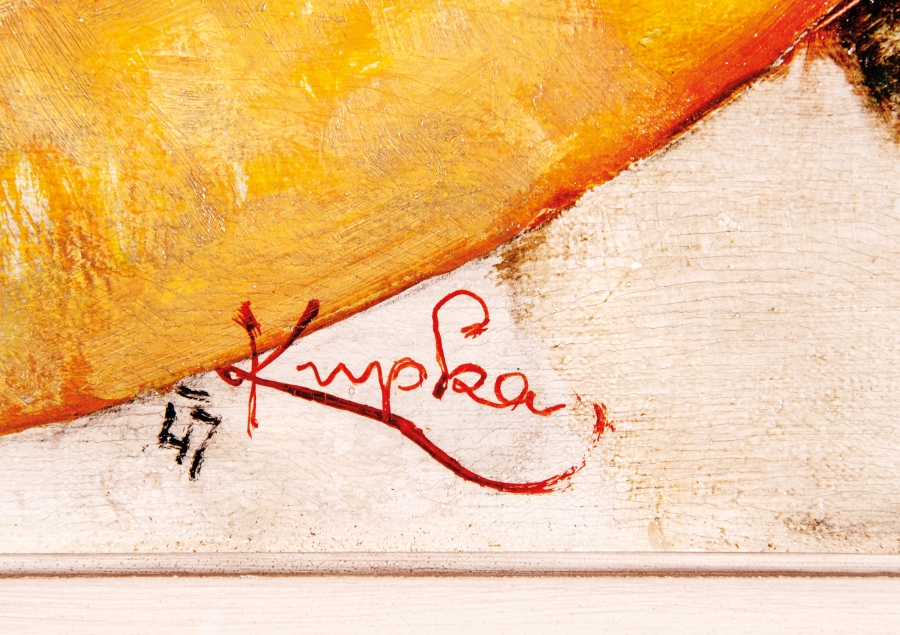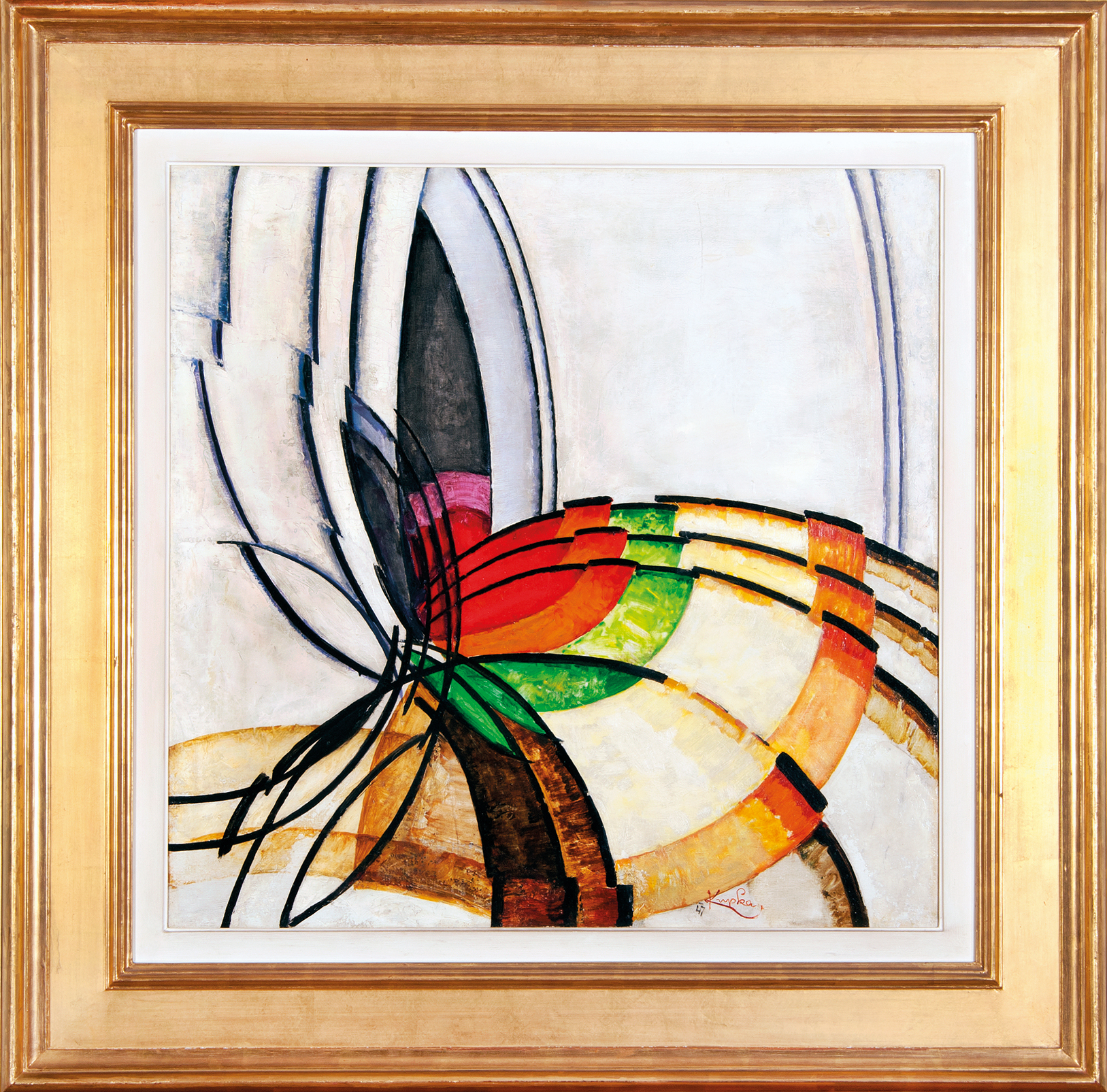





Lot 108 Prisme
Created:
1913 - 1947
Oil on canvas
Dimensions: 70,5 x 70,5 cm
Signed and dated lower right "Kupka 47"
Kupka has started painting this picture before the First World War.
Provenance:- in 1951 a well-known Parisian gallerist Louis Carré bought the painting directly from Frantisek Kupka. In the same year Kupka, who was eighty years old, appointed the gallerist his first official representative. Kupka was introduced to Carré by painter Jacques Villon, a neighbour of his from Puteaux. At that time, Louis Carré represented internationally known artists such as Pablo Picasso, Jacques Villon, Alexander Calder, Fernand Léger, André Lanskoy, etc. According to Carré’s grandson, his grandfather bought at that time circa 50 paintings from Kupka, which he later sold to internationally prominent galleries and museums, e.g. Museum of Modern Art in New York, Solomon R. Guggenheim Museum in New York, Aichi Prefectural Museum of Art in Tokyo, The Rothschild collection in New York, Museo Thyssen-Bornemisza Madrid, etc. Louis Carré sold paintings to Jan and Meda Mládek (in 1975 they bought the crucial Kupka’s paintings Cathedral and The Fair).
- collection of Louis Carré
- Philips London, Modern Paintings, Watercolours & Sculptures, 04.04.1990, lot 47
- Christie´s New York, Impressionist and Modern Art, 02.11.2005, lot 495
- private collection
Exhibited:- "From classical modernism to contemporary art", MIRO Gallery Prague in cooperation with Gallry Michael Haas, Berlin/Zurich. (12.09. - 20.11.2016)
Publicated:- the painting is listed in Frantisek Kupka´s Catalogue Raisonné of Oil Paintings, Adolf Loos Apartment and Gallery, Belvedere Vienna, National Gallery in Prague, page 199, no. 109.
A confirmation of the authenticity by Vladimir Lekes, the author of Kupka’s Catalogue Raisonné of Oil Paintings attached. (published with cooperation of Adolf Loos Apartment and Gallery, National Gallery Prague, Belvedere Vienna and the owner of Kupka´s resale rights Adagp Paris) Vladimir Lekes is also listed in Guide international des experts et spécialistes, published in France.
Confirmation of the authenticity by Pierre Brulle, dated 27. April 2007, attached (Curator of the exhibition "Frantisek Kupka – The Way to Amorfa", National Gallery in Prague, 30, November 2012 – 3, March 2013).
Consulted with Professor Jaromir Zemina and Professor Tomas Vlcek.
The restoration expertise and an X-ray image made by conservator-restorer specialist Martin Martan attached.
From 1951 the painting is recorded in archive of Louis Carré´s Gallery in Paris.The painting is listed in Kupka’s Catalogue Raisonné of Oil Paintings, no. 109 and also belonged to significant serie of Fugue in Two Colors.
According to George Waldes (the oldest son of a well-known gallerist and art collector George Waldes who was also a very close Kupka´s friend and his only supporter during his life) Kupka frequently came back to his unfinished paintings to rework them or finally finish them, even after a few decades. Kupka couldn´t work during the First or even Second World War. While during the WWI he was an active soldier and was also seriously wounded, during the WWII he moved to Beaugency. George Waldes was a very good friend of Kupka and they often visited each other. George would come to his atelier in Puteaux for holidays and Kupka with his wife would often go to Prague to see George and his family. In Puteaux or in Prague Kupka would teach George how to paint and with his wife Eugenia also taught George french language.
Frantisek Kupka was both an extraordinary person and a remarkable artist. His life story reminds of a fiction novel, and is full of surprising turns of fate. The same is true of his work. From a provincial apprentice, he had become a famous artist; one of those who not only enriched the painting of the early 20th century, but showed it a new direction. Repeatedly, Kupka stepped into the unknown. He had the chance to become a successful academic painter in Prague and Vienna. Likewise he could have remained a renown satirical draftsman, an admired illustrator, a symbolist, and a remarkable postimpressionistic painter. Yet, he rather became Kupka - a pioneer of non-figurative art of the 20th century. However, unlike his more famous contemporaries, he was to taste the bitterness of no recognition, and was almost forgotten. During his life, this creator of new art experienced more disappointment than fame. His legacy was only recognised after his death.
What was it that made the founders of abstraction including Kupka, Kandinsky, Mondrian, Malevich and Delaunay so determined to free art from its direct dependance on optical experience and find a new different form of art? Perhaps it is a paradox, but they were all driven by the same dissatisfaction with the state of human society and human existence. Like the avant-gardists, even they felt that individual freedom was threatened, and new order was needed. Yet, artists such as Kupka, Kandinsky and Mondrian made more radical moves than Matisse, Picasso and Braque ever imagined. Likewise, they were more philosophical, and fully committed to art theory. For them, the struggle for new art was a struggle for new human being and a new world. Kupka succeeded in reaching a variety of art forms that could express the astonishing breadth of his ideas. He is a founder of geometrical abstraction, yet he had also explored completely different possibilities of artistic expression. It is precisely in his inquiry into the in-between states, where he remained alone. Among other things, Kupka created an entirely personal version of non-figurative creation – imaginative, fantastic abstraction rooted in symbolism and Art Nouveau, almost approaching surrealism. We could point to the incredibly similar artistic results achieved by Kupka in Paris and by Malevich in Russia. It is a harmony that the world´s avant-garde was destined to reach.
Bidders for this object who have never bought an item from our auction house will have to agree to the conditions of their participation before the auction.Reduced buyer’s commission for this lot: 7 % included VAT and Droite de Suite.
Bidders for this object who have never bought an item from our auction house will have to agree to the conditions of their participation before the auction.Reduced buyer’s commission for this lot: 7 % included VAT and Droite de Suite.
Price realized
-
This is the last item in the auction.
